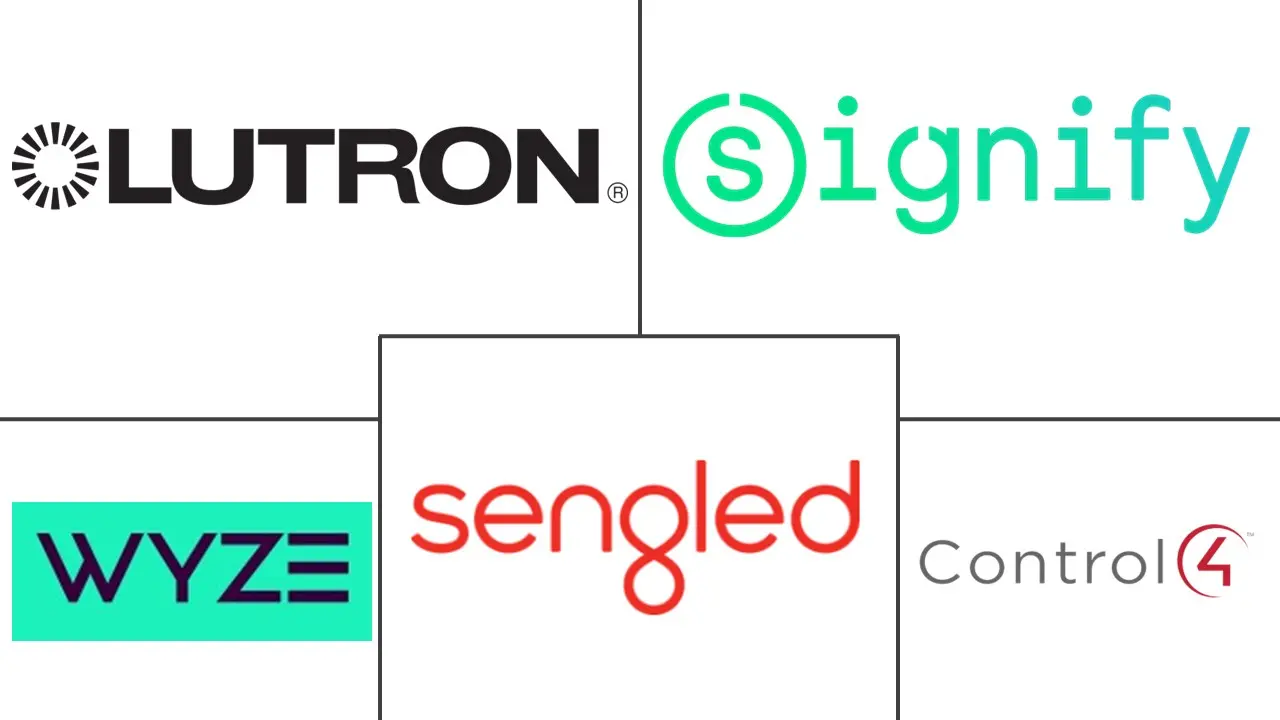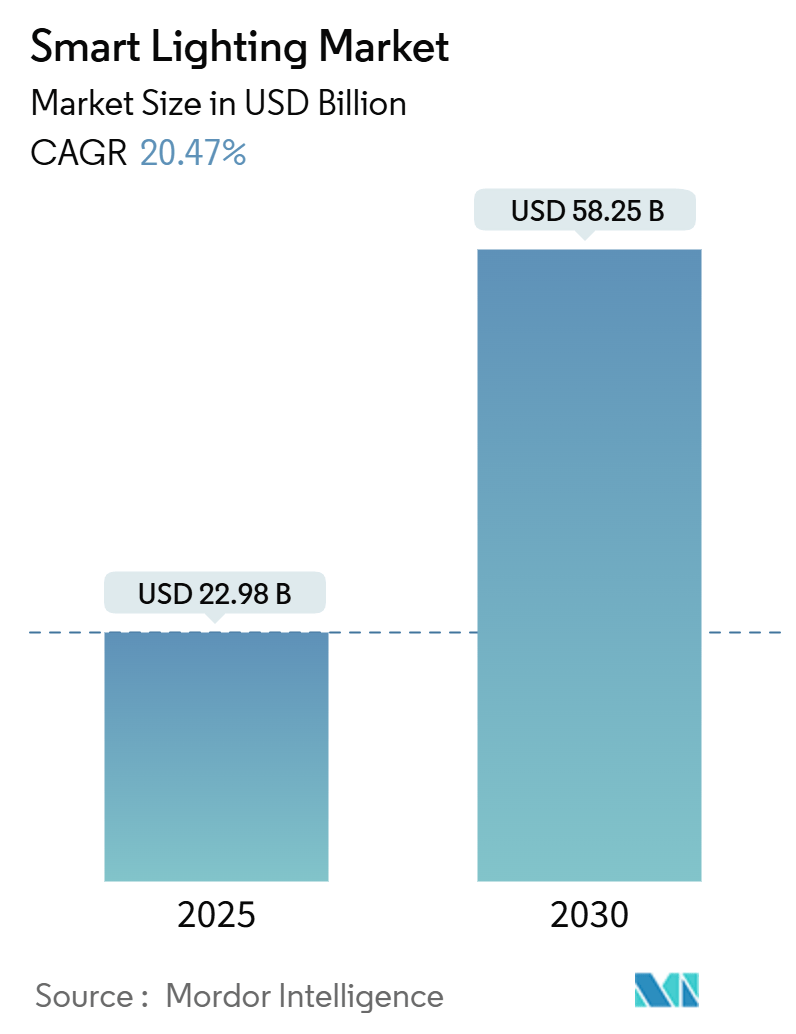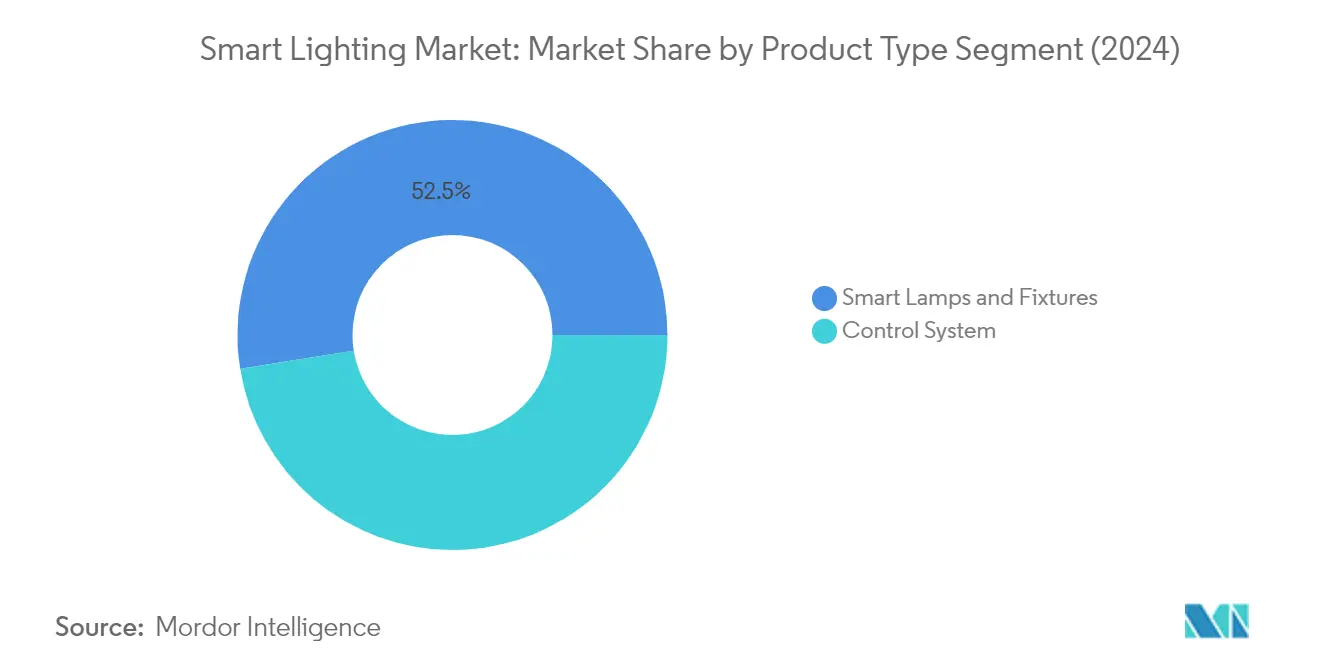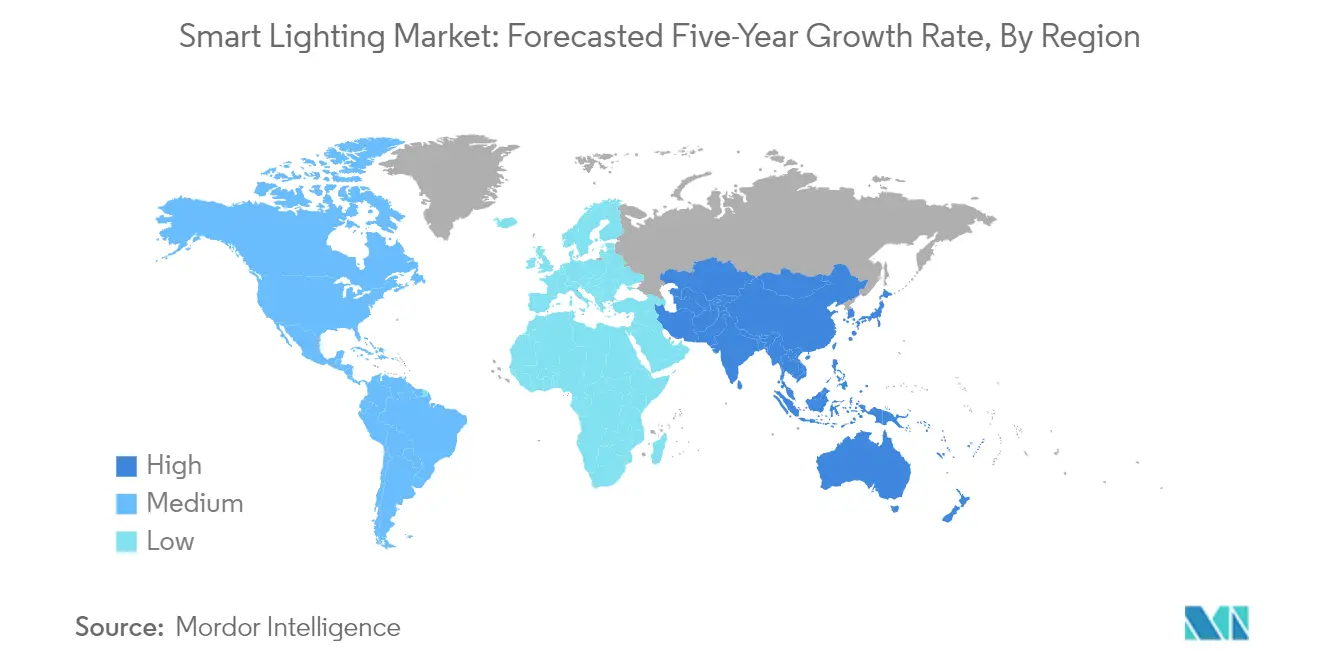Smart Lighting Market Analysis
The Smart Lighting Market size is estimated at USD 22.98 billion in 2025, and is expected to reach USD 58.25 billion by 2030, at a CAGR of 20.47% during the forecast period (2025-2030).
The smart lighting industry is experiencing a transformative shift driven by the convergence of IoT lighting technology and energy efficiency imperatives. According to the International Energy Agency, buildings and construction collectively account for approximately 30% of global final energy consumption, highlighting the critical need for smart lighting solutions. The United Nations Environment Programme Copenhagen Climate Centre reports that smart street lighting alone accounts for 15% of global power consumption, emphasizing the substantial impact potential of intelligent lighting technologies. This transformation is further accelerated by the increasing integration of connected lighting with building management systems, enabling comprehensive energy monitoring and optimization capabilities.
The industry is witnessing significant technological advancements with the introduction of sophisticated control systems and connectivity features. In September 2022, Signify unveiled its novel SpaceSense feature for WiZ-connected home lighting, which utilizes Wi-Fi sensor technologies to detect movement and automatically control lighting systems. The integration of artificial intelligence and machine learning capabilities is enabling predictive maintenance, automated scheduling, and personalized lighting experiences. According to Strategy Analytics, the number of IoT-connected devices is anticipated to reach 50 billion by 2030, creating extensive opportunities for smart lighting integration and automation.
Corporate and commercial adoption of smart lighting solutions continues to expand, particularly in office environments where lighting significantly impacts employee well-being and productivity. According to the Carbon Trust, lighting accounts for approximately 20% of total electricity consumption in the UK, with this figure rising to 39% in typical office buildings and reaching even higher percentages in specialized contexts such as healthcare facilities (43%) and hotels (55%). This has led to increased implementation of human-centric lighting solutions that adjust color temperature and intensity throughout the day to support natural circadian rhythms.
International collaborations and smart city initiatives are driving large-scale smart lighting deployments worldwide. In February 2023, Singapore companies announced collaboration with United Arab Emirates firms to develop smart city pilot projects in Abu Dhabi, focusing on transforming street lighting and increasing energy efficiency. Similarly, in January 2023, the government of Bulgaria announced a USD 34.08 million investment in energy-efficient street lighting systems across 74 municipalities. These initiatives demonstrate the growing recognition of smart lighting as a fundamental component of urban infrastructure modernization, with implementations focusing on both energy efficiency and enhanced functionality through features such as environmental monitoring and traffic management capabilities.
Smart Lighting Market Trends
Increasing Demand for Energy Saving at Homes
The growing concerns about energy consumption and costs have made energy-efficient lighting solutions increasingly attractive for residential applications. According to the International Energy Agency (IEA), buildings and building construction collectively account for approximately 30% of global final energy consumption, with lighting being a significant contributor. The transition to LED smart lighting offers substantial energy savings, as LEDs use about 80% less energy than traditional incandescent bulbs and last up to 25 times longer. Modern LED solutions deliver 80-100 lumens per watt compared to just 15 lumens per watt for traditional incandescent bulbs and 20 lumens per watt for halogen alternatives, making them significantly more efficient.
The United States Department of Energy projects that widespread adoption of LED lighting could result in energy savings of 569 TWh annually by 2035, equivalent to the annual energy output of approximately 92 1,000 MW power plants. This potential for energy conservation is driving homeowners to invest in smart home lighting solutions that offer both energy efficiency and enhanced control capabilities. The United Nations Environment Programme (UNEP) Copenhagen Climate Centre reports that street lighting alone accounts for 15% of global power consumption, highlighting the massive potential for energy savings through smart lighting adoption in both residential and public spaces. The ability to monitor and optimize energy usage through smart lighting control systems, coupled with the long-term cost savings from reduced energy consumption and extended product lifespans, continues to drive residential adoption of smart lighting solutions.
Government Regulations Mandating the Use of LEDs
Government initiatives and regulations worldwide are actively promoting the transition to energy-efficient lighting solutions through performance standards, labeling requirements, and incentive programs. In January 2023, the Government of Ukraine announced a comprehensive program to replace incandescent light bulbs with LED alternatives as part of the European Union's support for the country's energy infrastructure. Similarly, the Bulgarian government has committed $34.08 million in January 2023 to implement energy-efficient street lighting systems across 74 municipalities, demonstrating the growing governmental push toward sustainable lighting solutions. These initiatives are complemented by stringent regulations, such as the United States law mandating energy savings of 45 lumens per watt for common light bulbs.
The regulatory landscape continues to evolve with recent updates to the European Union's Ecodesign Directive and the Restriction of Hazardous Substances Directive, which will effectively phase out all fluorescent lighting by 2023. This transition is not limited to developed markets, as evidenced by the adoption of harmonized lighting standards by 16 African nations in the Southern African Development Community (SADC), committing to a complete transition to LED technology. Additionally, the East African Community (EAC) is implementing similar phase-outs of fluorescent lighting across six member nations, while Southeast Asian countries are developing comparable regulatory frameworks. These coordinated governmental efforts to eliminate inefficient lighting technologies are creating a strong regulatory foundation for the continued growth of the LED smart lighting market.
Segment Analysis: By Product Type
Smart Lamps and Fixtures Segment in Smart Lighting Market
Smart lamps and fixtures represent the dominant segment in the smart lighting market, commanding approximately 53% market share in 2024, while also demonstrating the strongest growth trajectory. These solutions encompass a wide range of products, including smart bulbs, light strips, table lamps, floor lamps, recessed lights, spotlights, wall lights, ceiling lights, pendant lights, path lights, and light bars. The segment's leadership position is driven by increasing consumer preference for energy-efficient lighting solutions that offer enhanced control and customization capabilities. Smart lamps and fixtures are particularly appealing due to their ability to integrate seamlessly with home automation systems, supporting features such as voice recognition, remote operation, and automated scheduling. The rising adoption of LED technology, coupled with the growing awareness of energy conservation in residential and commercial spaces, continues to fuel the segment's expansion. Additionally, manufacturers are increasingly focusing on developing innovative products with advanced features such as tunable white light, color-changing capabilities, and integration with smart assistants, further strengthening the segment's market position.
Control System Segment in Smart Lighting Market
The lighting control system segment, encompassing both wired and wireless lighting control solutions, plays a crucial role in the smart lighting ecosystem by providing the essential infrastructure for managing and automating lighting operations. Control systems enable sophisticated features such as daylight harvesting, occupancy sensing, and scheduled lighting adjustments, making them indispensable for both residential and commercial applications. The segment includes various components such as controllers, switches, dimmers, sensors, and gateways that work together to create intelligent connected lighting systems. Wireless control systems are gaining particular traction due to their ease of installation and flexibility in retrofitting existing infrastructure. The integration capabilities of these systems with building management systems and IoT platforms are driving their adoption in smart building projects. Furthermore, the development of more sophisticated control protocols and standards is enhancing the interoperability and functionality of these systems, making them increasingly attractive to end-users seeking comprehensive lighting management solutions.
Smart Lighting Market Geography Segment Analysis
Smart Lighting Market in North America
North America represents one of the most technologically advanced markets for smart lighting solutions, driven by the rapid adoption of home automation systems and IoT technologies. The United States and Canada are the key markets in this region, with a strong presence of major smart lighting manufacturers and innovative startups. The region's growth is supported by favorable government regulations promoting energy-efficient lighting solutions and increasing awareness about residential smart lighting technologies among consumers.
Smart Lighting Market in United States
The United States dominates the North American smart lighting market as the largest market in the region. The strong financial position of the country has enabled enterprises to invest in advanced solutions and technologies like the Internet of Things (IoT) and Li-Fi, which contribute to the development of smart lighting. With approximately 89% share of the North American market in 2024, the US market is driven by increasing energy consumption and the Climate Smart Buildings Initiative. The country's focus on developing smart cities and implementing connected technologies has created numerous opportunities for commercial smart lighting vendors.
Smart Lighting Market Growth Trends in United States
The United States continues to demonstrate robust growth potential in the smart lighting market, with an expected growth rate of approximately 21% during 2024-2029. The country's commitment to energy efficiency is evident through various initiatives and programs. The federal government's Climate Smart Buildings Initiative aims to boost performance contract spending significantly, creating substantial opportunities for smart lighting players. Cities across the country are implementing advanced lighting control systems, with initiatives like wireless LED lights that can be dimmed or controlled remotely gaining prominence.
Smart Lighting Market in Europe
Europe stands at the forefront of smart lighting adoption, with a well-established market infrastructure spanning the United Kingdom, Germany, France, and Spain. The region's commitment to energy efficiency and sustainable urban development has created a favorable environment for smart lighting solutions. European countries have been particularly proactive in implementing smart city initiatives and promoting energy-efficient lighting technologies through various government programs and regulations.
Smart Lighting Market in Germany
Germany emerges as the largest smart lighting market in Europe, commanding approximately 23% of the regional market share in 2024. The country's automotive industry, being the largest in Europe, creates significant opportunities for smart lighting applications. The nation's focus on innovation and technological advancement has attracted major players in the smart lighting industry, with companies like Signify establishing a strong presence in the market.
Smart Lighting Market Growth Trends in Spain
Spain demonstrates the highest growth potential in the European smart lighting market, with a projected growth rate of approximately 22% during 2024-2029. The country has been quick to adopt smart lighting technology for monitoring the performance of individual LED streetlights. Spain's commitment to reducing electricity consumption and CO2 emissions through efficient lighting solutions has driven significant investments in smart lighting infrastructure. The country's focus on modernizing public lighting systems and implementing energy-efficient technologies continues to create new opportunities for market growth.
Smart Lighting Market in Asia-Pacific
The Asia-Pacific region represents a dynamic market for smart lighting solutions, encompassing diverse economies like China, Japan, and India. The region's rapid urbanization, increasing adoption of IoT technologies, and growing awareness about energy efficiency are driving market growth. Government initiatives promoting smart city development and energy-efficient lighting solutions have created a favorable environment for market expansion.
Smart Lighting Market in China
China leads the Asia-Pacific smart lighting market, demonstrating strong market dominance through its robust manufacturing capabilities and extensive smart city initiatives. The country's large-scale infrastructure development and increasing adoption of smart home technologies have created substantial opportunities for smart lighting solutions. The government's focus on energy efficiency and sustainable urban development continues to drive market growth.
Smart Lighting Market Growth Trends in India
India emerges as the fastest-growing market in the Asia-Pacific region for smart lighting solutions. The country's rapid urbanization, growing awareness of energy-efficient lighting solutions, and various government initiatives promoting LED adoption are driving market growth. The implementation of programs like the "Street Lighting National Program" and the development of smart cities are creating new opportunities for smart lighting vendors.
Smart Lighting Market in Latin America
The Latin American smart lighting market is experiencing steady growth, driven by increasing urbanization and government initiatives promoting energy-efficient lighting solutions. The region's focus on smart city development and sustainable infrastructure has created opportunities for smart lighting implementation. Brazil emerges as both the largest and fastest-growing market in the region, with its expanding middle-class population and increasing inclination toward smart lighting solutions. The country's major cities, including São Paulo and Rio de Janeiro, are leading the adoption of smart lighting technologies through various smart city initiatives.
Smart Lighting Market in Middle East & Africa
The Middle East & Africa region demonstrates significant potential in the smart lighting market, driven by steady growth in infrastructure and real estate sectors, particularly in key countries like the United Arab Emirates and Saudi Arabia. Local governments play a significant role in adopting smart lighting technology through various initiatives and projects. The UAE emerges as both the largest and fastest-growing market in the region, with its ambitious smart city initiatives and commitment to energy-efficient lighting solutions. The region's focus on sustainable development and energy efficiency continues to create new opportunities for smart lighting implementation.
Smart Lighting Industry Overview
Top Companies in Smart Lighting Market
The smart lighting market features prominent players like Signify Holding, Eaton Corporation, Acuity Brands, OSRAM, and other established manufacturers who are actively shaping industry dynamics through continuous innovation. These smart lighting companies are focusing on developing advanced IoT-enabled lighting solutions, incorporating features like voice control compatibility, motion sensing, and energy optimization capabilities. Strategic partnerships with technology providers and cloud platform companies have become increasingly common to enhance product capabilities and provide seamless digital experiences. Companies are also expanding their manufacturing footprint across different regions while simultaneously strengthening their distribution networks through both online and offline channels. The emphasis on research and development remains strong, with companies investing in new technologies like Matter certification, wireless mesh networks, and integrated building management systems to stay competitive.
Market Consolidation Drives Industry Evolution Pattern
The smart lighting industry exhibits a mix of global conglomerates and specialized lighting technology providers, with larger players leveraging their established brand presence and extensive distribution networks to maintain market dominance. These major players are increasingly pursuing vertical integration strategies, developing in-house capabilities across upstream, midstream, and downstream operations to better control quality and costs. The market has witnessed significant consolidation through strategic acquisitions, with larger companies acquiring smaller innovative firms to expand their technological capabilities and geographical presence.
The competitive landscape is characterized by intense rivalry, particularly in the LED segment, where Asian manufacturers have entered with cost-competitive offerings. Market leaders are responding through differentiated product offerings, enhanced service capabilities, and strategic collaborations with smart home ecosystem providers. The industry has seen notable merger and acquisition activities, particularly in North America and Europe, as companies seek to strengthen their market positions and acquire complementary technologies in areas like controls and sensors.
Innovation and Integration Key to Success
Success in the smart lighting market increasingly depends on companies' ability to develop integrated solutions that seamlessly connect with broader smart home and building management systems. Manufacturers need to focus on developing products with enhanced interoperability, improved energy efficiency, and advanced control features while maintaining competitive pricing. Companies must also invest in strengthening their supply chain resilience, particularly in component sourcing and manufacturing, while building strong relationships with technology partners and system integrators to ensure comprehensive solution delivery.
Future market leadership will require companies to address growing concerns around cybersecurity, data privacy, and environmental sustainability. Successful players will need to navigate evolving regulatory requirements around energy efficiency and environmental impact while maintaining product innovation momentum. Companies must also focus on developing user-friendly interfaces and applications that simplify the adoption and operation of smart lighting solutions, while building strong after-sales support networks to ensure customer satisfaction and loyalty. The ability to provide scalable solutions that can adapt to both residential and commercial applications while maintaining cost-effectiveness will be crucial for long-term success.
Smart Lighting Market Leaders
-
Control4 Corp. (Snap One LLC)
-
Lutron Electronics Co. Inc
-
Signify N.V.
-
Wyze Labs Inc.
-
Sengled
- *Disclaimer: Major Players sorted in no particular order
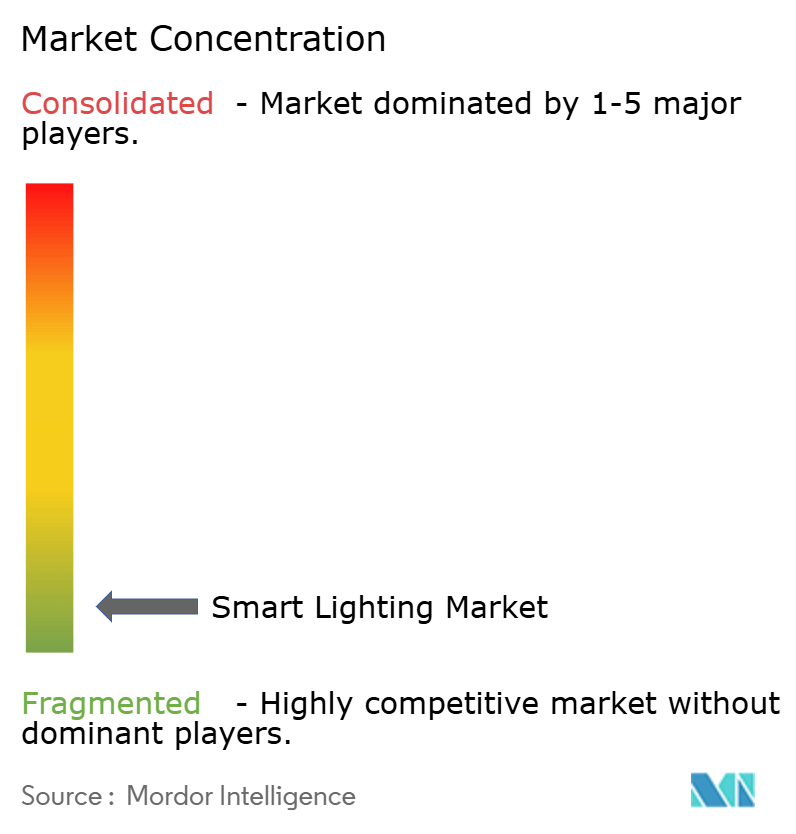
Smart Lighting Market News
- July 2024: GE Lighting, a Savant company, has partnered with SmartThings, Samsung Electronics Co., Ltd.'s global connected living platform, to redefine smart home lighting solutions. This collaboration aims to provide consumers with an expanded range of innovative connected lighting options for their homes. With Matter compatibility, Cync Reveal undercabinet fixtures now integrate seamlessly with SmartThings. This integration revolutionizes kitchen lighting by offering customizable solutions that adapt effortlessly to users' lifestyles and preferences.
- April 2024: Resideo Technologies, Inc., a prominent manufacturer and distributor of technology-driven solutions, announced its agreement to acquire Snap One Holdings Corp., a leading provider of smart-living products and software for professional integrators. The deal is valued at approximately USD 1.4 billion, including net debt. Following the acquisition, Snap One will integrate into Resideo’s ADI Global Distribution business. This strategic move combines ADI’s established expertise in security product distribution with Snap One’s innovative smart-living solutions and Control4 technology platforms, aiming to deliver enhanced value to integrators and improved financial outcomes.
Smart Lighting Market Report - Table of Contents
1. INTRODUCTION
- 1.1 Study Assumptions and Market Definition
- 1.2 Scope of the Study
2. RESEARCH METHODOLOGY
3. EXECUTIVE SUMMARY
4. MARKET INSIGHTS
- 4.1 Market Overview
-
4.2 Industry Attractiveness - Porter's Five Forces Analysis
- 4.2.1 Bargaining Power of Suppliers
- 4.2.2 Bargaining Power of Buyers
- 4.2.3 Threat of New Entrants
- 4.2.4 Threat of Substitute Products and Services
- 4.2.5 Degree of Competition
- 4.3 Industry Value Chain Analysis
- 4.4 PESTLE Analysis
5. MARKET DYNAMICS
-
5.1 Market Drivers
- 5.1.1 Increasing Demand for Energy Saving at Homes
- 5.1.2 Government Regulations Mandating the Use of LEDs
-
5.2 Market Challenges
- 5.2.1 Lack of Awareness Regarding Selection and Installation of Products
-
5.3 Market Opportunities
- 5.3.1 Increasing Adoption of IoT in Emerging Economies
6. WIRELESS CONNECTIVITY STANDARD TYPES USED IN RESIDENTIAL SMART LIGHTING PRODUCTS
- 6.1 Wi-Fi
- 6.2 Bluetooth
- 6.3 ZigBee
7. MARKET SEGMENTATION
-
7.1 By Product Type
- 7.1.1 Control System
- 7.1.1.1 Wired
- 7.1.1.2 Wireless
- 7.1.2 Smart Lamps and Fixtures
-
7.2 By Geography***
- 7.2.1 North America
- 7.2.1.1 United States
- 7.2.1.2 Canada
- 7.2.2 Europe
- 7.2.2.1 United Kingdom
- 7.2.2.2 Germany
- 7.2.2.3 France
- 7.2.2.4 Spain
- 7.2.3 Asia
- 7.2.3.1 China
- 7.2.3.2 Japan
- 7.2.3.3 India
- 7.2.4 Australia and New Zealand
- 7.2.5 Latin America
- 7.2.6 Middle East and Africa
8. COMPETITIVE LANDSCAPE
-
8.1 Company Profiles
- 8.1.1 Control4 Corp. (Snap One LLC)
- 8.1.2 Lutron Electronics Co. Inc.
- 8.1.3 Signify N.V.
- 8.1.4 Wyze Labs Inc.
- 8.1.5 Sengled
- 8.1.6 GE Lighting (Savant Systems Inc .)
- 8.1.7 Eaton Corporation Plc
- 8.1.8 Acuity Brands Inc.
- 8.1.9 Hubbell Incorporated
- 8.1.10 Crestron Electronics Inc.
- 8.1.11 Insteon (Smartlabs Inc.)
- 8.1.12 EGLO Leuchten GmbH
- 8.1.13 Eve Systems GmbH
- 8.1.14 Nanoleaf Canada Ltd.
- 8.1.15 Wipro Lighting Limited
- 8.1.16 Xiaomi Corporation
- 8.1.17 Feit Electric (LIFX)
- *List Not Exhaustive
9. VENDOR MARKET SHARE ANALYSIS FOR CONTROL SYSTEMS
10. INVESTMENT ANALYSIS
11. FUTURE OF THE MARKET
Smart Lighting Industry Segmentation
Smart/connected lighting is defined as an LED-based system with sensors and controllers that are networked (wired or wireless) and enable the lighting products within the system to communicate with each other and transmit data. LED lighting solutions that allow them to be connected, customized, scheduled, and remotely controlled include smart lamps, bulbs, and luminaires. Lighting controls include sensors, user interfaces, controllers, and light management software.
The smart lighting market is segmented into product type (control systems (wired, wireless), smart lamps and fixtures) and geography (North America [United States, Canada], Europe [United Kingdom, Germany, France, Spain, and Rest of Europe], Asia Pacific [China, Japan, India, Rest of Asia Pacific], Latin America, Middle East and Africa). The market sizes and forecasts are provided in terms of value (USD) for all the above segments.
| By Product Type | Control System | Wired | |
| Wireless | |||
| Smart Lamps and Fixtures | |||
| By Geography*** | North America | United States | |
| Canada | |||
| Europe | United Kingdom | ||
| Germany | |||
| France | |||
| Spain | |||
| Asia | China | ||
| Japan | |||
| India | |||
| Australia and New Zealand | |||
| Latin America | |||
| Middle East and Africa | |||
Smart Lighting Market Research FAQs
How big is the Smart Lighting Market?
The Smart Lighting Market size is expected to reach USD 22.98 billion in 2025 and grow at a CAGR of 20.47% to reach USD 58.25 billion by 2030.
What is the current Smart Lighting Market size?
In 2025, the Smart Lighting Market size is expected to reach USD 22.98 billion.
Who are the key players in Smart Lighting Market?
Control4 Corp. (Snap One LLC), Lutron Electronics Co. Inc, Signify N.V., Wyze Labs Inc. and Sengled are the major companies operating in the Smart Lighting Market.
Which is the fastest growing region in Smart Lighting Market?
Middle East and Africa is estimated to grow at the highest CAGR over the forecast period (2025-2030).
Which region has the biggest share in Smart Lighting Market?
In 2025, the Asia Pacific accounts for the largest market share in Smart Lighting Market.
What years does this Smart Lighting Market cover, and what was the market size in 2024?
In 2024, the Smart Lighting Market size was estimated at USD 18.28 billion. The report covers the Smart Lighting Market historical market size for years: 2020, 2021, 2022, 2023 and 2024. The report also forecasts the Smart Lighting Market size for years: 2025, 2026, 2027, 2028, 2029 and 2030.
Our Best Selling Reports
Smart Lighting Market Research
Mordor Intelligence provides comprehensive insights into the rapidly evolving smart lighting industry. We offer detailed market analysis and consulting services. Our extensive research covers the entire spectrum of intelligent lighting technologies. This includes LED smart lighting and advanced IoT lighting solutions. The report delivers an in-depth analysis of commercial smart lighting, residential smart lighting, and industrial smart lighting segments. Additionally, it examines crucial developments in smart street lighting and building automation lighting systems.
Stakeholders across the lighting control system value chain can access crucial data about automated lighting trends and digital lighting innovations. Our report is easily available for download in PDF format. The analysis encompasses wireless lighting control technologies, networked lighting infrastructure, and connected lighting systems. It provides strategic insights for businesses operating in the smart lighting solutions space. Our research methodology evaluates adaptive lighting implementations and intelligent light control mechanisms. This offers stakeholders a thorough understanding of market dynamics, growth projections, and competitive landscapes across residential, commercial, and industrial applications.

